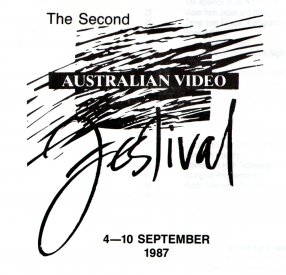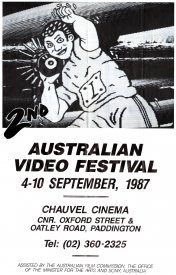Co-ordinator: Sally Couacaud
Assistant Co-ordinator: Kate Goodnow
Board members:
Jill Scott - President
Annmarie Chandler - Vice President
Peter Callas
Michael Hobbs
Eddy Jokovich
Brian Langer
Jeremy Saxton
Design: Richard Knight
The Australian Video Festival Ltd 1987
Box 316 Paddington, NSW 2021
Catalogue
[2nd AVF catalogue p.3]
C O N T E N T S
4 Introduction: President, Australian Video Festival [below]
5 International Programme
6 Voice(s) and Memory [below]
8 Two Installations. Art Gallery of NSW
11 Terrorising the Code - Recent U.S. Video
19 International Video Installation
22 Chauvel Screenings
The Absence of Reflection: Video, Lunacy and Post-Culture Japan
23 Video from Japan and Background Video
25 Tapes from Europe: A programme of video creation
28 Scratch Video
30 Video from S.E. Asia
32 Vide-Art-Music-Performance Night
34 German Video Art
38 Educational, Technology and the Future
39 Introdution: Annmarie Chandler
39 Demonstrations/Displays/Special Events
40 Festival Forums
40 Videometro Workshops
41 Aerial Perspectives: Aussat
42 Video Producers Discover Teleconferencing
44 Interactive Laser Disc Installations: Lateral Thinking
46 Computer Imagery
49 Women and High Technology
51 Aboriginal Programming
54 Public Television: Three Voices from the Void
56 Notes for a Peoples Television - In Search of Strategies for Diverse TV
59 The Australian Video Festival Awards
Computer Graphics
Corporate Video
Documentary
Drama Narrative
Music Video
Video Art
Judges/QANTAS AWARD
Home Video
76 Listings
[4] K I N E T I C E X C l T E M E N T
Welcome to the second annual Australian Video Festival where many answers will be found to explain why Video is growing so rapidly as a medium of expression.
While the first festival last year served as a great introduction to the diversity and prolificy of production surrounding the medium, the second is divided into three basic areas of focus.
1. The Australian Awards of Excellence
2. The International Selection
3. Education, Technology and the Future
The first section are National Awards for selected video works from independent directors, artists and producers, commercial video designers, animators and student directed productions. The scope of subject matter spans music video, video graphics, drama/narrative, documentary, corporate and informational video and video art.
Once again we are amazed at the amount of entries and we wish to thank all those who have participated. This year a new Home Video Award was introduced. We would like to extend thanks to the major sponsor in this area - Sony Australia.
The International selection is co-ordinated by the generous efforts of five curators who are presenting the most current and controversial works from Japan, USA, the South Pacific region and Europe. These programs are as diverse and exciting as the special overseas guests that accompany them. We hope you have the opportunity to see and hear all the video and guest speakers.
Education, Technology and the Future is a title we selected to house all the forums, discussions and information about technology, independent video production, showcasing and distribution. It was designed to be educational as well as critical and workshops and demonstrations play an important part.
Even though these sections are more defined and selective than last years', the Video Festival is a jam-packed activity every day for seven days and will be as kinetically exciting as ever.
We hope you are interested in seeing this major selection, alternative television and creative stimulation and education and wish to thank the Australian Film Commission, the Office of the Minister for the Arts and all the sponsors for their generous support.
Long Live Video.
Jill Scott, President, Australian Video Festival
----------------------------------------------------------------------------------
[6] VOICE(S) AND MEMORY
The relationship between the video maker and the video viewer is potentially quite distinct from that between readers and writers in other time based media and also separate from the modes of address prevalent in other art forms. However, although differences exist the similarities are also important in informing a still young practice. What is interesting is that the similarities may occur with what would seem to be more alien media to video than those with which it is most often associated.
Historically video is linked to film and performance, the first due to certain assumptions about time based imagery and the latter because of their concurrent development during the sixties often by the same artists. Video is also seen as often functioning primarily relative to television due to their similar delivery and technical production systems.
However, psychologically video can be seen to relate more closely to other art media, particularly in the relationship between author and reader. The dynamic of the communicative act, that which is central to any art activity, is the primary concern to be addressed in gaining access to both the artists intentions and the readers responses. It is the construction, or disintegration, of Self, both the artists and the readers, that is the process upon which art is predicated - as such, a psychological task founded upon integration. The experience of art is one incorporating a transferential dynamic, often as a conflict, within varying art forms and media.
In the instance of television this dynamic of Self/Other is constituted as the depersonalised or de-individuated voice of the broadcast and the singular Self of the viewer. The authorial voice of television is de-differentiated and unfixed, as information and a succession of ambiguous 'selves' are received into the personal space of the home. Regardless of the program being broadcast, whether a Bergman film, a game show or a soap, the pervasively ambivalent context within which it is delivered is that which is television. In such a context the manner in which the viewer views - the differentiation of Self relative to the media form - is distinct from that of other media, even when the material originated elsewhere and was transferred (eg; film onto television).
A problem here for the video artist is how to deal with the possibility of having their work broadcast on television. It may be that they will need to forget about video art and operate as producers of television. There is nothing wrong with this strategy, as has been realised in countries where video art is regularly programmed (specifically commissioned rather than bought in), however it would appear that for many artists television is primarily seen as a means of access to a larger audience and almost incidental to their central activity. Although television does deliver people (as observed by Richard Serra) the nature of that audience dictates a particular approach which may well be entirely alien to video art. Alternatively, many artists see television as a form of reward (eg; 'After all these years video/my art is finally receiving the recognition it deserves') and in this case the artists attitude is in danger of placing them in a subjugated relationship with television that would disallow them the capacity to address it with a creative and critical eye. It may be that given the current characteristics of television and video art they are not only distinct but possibly antithetical to one another.
In the case of film the authorial voice is singular, often didactic, whilst the cinema audience is experientially plural. It is, in a sense, the complete opposite of the transferential dynamic of television. However, in the case of video art the author and reader are both singular, one voice addressing one viewer. It is a personalised dynamic more akin to that existent in the mode of literature, and more particularly within poetry.
Most video art is short when compared to film and long when seen alongside commercials (within which can be included music video). It is the commercial which sets the agenda and character of television as it is the theatrical devices of the scene and scenario that define the overwhelming balance of the cinema.
In the commercial we have a mini-scene, a singular statement designed to be assimilated immediately. The film, dealing with larger quantities of information perhaps of a more ambiguous intent, structures itself into a series of short narratives, each oriented to supply a statement or image which, as the film progresses, we compare and collate into the filmic, essentially theatrical narrative. What both media are here addressing is their shared primary characteristic - time, and the human function relative to it - memory. The T.V. commercial attempts to subvert memory by delivering the information quickly and forcibly whilst the film sets out to manipulate it by establishing a hierarchy of readable signals within a layered narrative (eg; the narrative of the individual scene becomes subsumed into the meta-narrative of the film? overall structure).
As with performance art video ad has tended to reject these forms of structured time and narrative by attempting to employ a form of simultaneity predicated upon a more de-differentiated and seemingly organic non-narrative. An example of this tendency is the performance of Pina Bausch or Station House Opera and the video of Bill Seaman and Bill Viola.
It is not that one can suggest an optimum length for video art tapes, that the time/memory relationship is a quantitative one, but rather that a particular approach is prevalent amongst those artists who have established an original voice for their medium that takes into account the different notions of scale and structure that apply to it.
In Bill Viola's Anthem, an eleven minute piece, the material is not placed in a sequential narrative, as in film, nor as a fragmented or exploded narrative, as with experimental (eg; Stan Brakhage or Warhol) film, but rather as a complex of associations. These are deployed relative to one another, in time, such that any sequentiality or hierarchisation is avoided, thus allowing the viewer to construct their own readings. In this manner Viola's work is highly poetic in the sense that poetry can function separate of prose narrative by creating a set of simultaneous associations that exist outside the memory constraints of the narrative structure.
As such, it may be that a critical reading of video (and the development of a meta-language to allow a discourse alongside it) will be enhanced by taking an essentially psycho-analytic approach, involving Klienian Object Relations Theory, in discussing its definition and constitution. In this particular case examining the notions of the transference relative to the relationship between author and reader within the different media contexts and exploring the function of memory and the narrative in conjunction with the medium? primary quality - time. Hopefully this represents a means to exit the tautological definitions that dominate discourse on video art.
[author not attributed in catalogue]

![Cover of the catalogue for the 2nd Australian Video Festival, 1987. [Image by Video Paint Brush Company].](../sites/default/files/imagecache/mediaviewer/AVF-87_Catalog_cover_1000H.jpg)


![Cover of the catalogue for the 2nd Australian Video Festival, 1987. [Image by Video Paint Brush Company]. Cover of the catalogue for the 2nd Australian Video Festival, 1987. [Image by Video Paint Brush Company].](../sites/default/files/imagecache/Medium/AVF-87_Catalog_cover_1000H.jpg)




